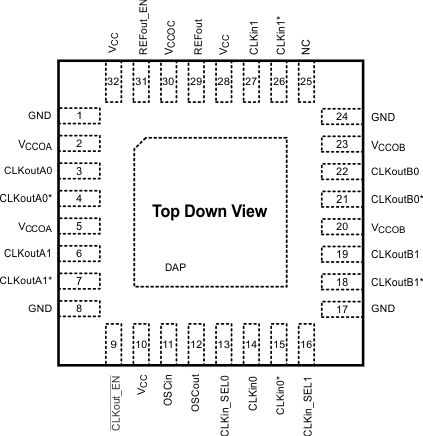SNAS760A April 2018 – January 2022 LMK00334-Q1
PRODUCTION DATA
- 1 Features
- 2 Applications
- 3 Description
- 4 Revision History
- 5 Pin Configuration and Functions
- 6 Specifications
- 7 Parameter Measurement Information
- 8 Detailed Description
- 9 Application and Implementation
- 10Power Supply Recommendations
- 11Layout
- 12Device and Documentation Support
- 13Mechanical, Packaging, and Orderable Information
Package Options
Mechanical Data (Package|Pins)
- RTV|32
Thermal pad, mechanical data (Package|Pins)
- RTV|32
Orderable Information
5 Pin Configuration and Functions
 Figure 5-1 RTV Package32-Pin WQFNTop View
Figure 5-1 RTV Package32-Pin WQFNTop ViewTable 5-1 Pin Functions(3)
| PIN | I/O | DESCRIPTION | |
|---|---|---|---|
| NAME | NO. | ||
| DAP | DAP | GND | Die Attach Pad. Connect to the PCB ground plane for heat dissipation. |
| CLKin_SEL0 | 13 | I | Clock input selection pins (2) |
| CLKin_SEL1 | 16 | I | Clock input selection pins (2) |
| CLKin0 | 14 | I | Universal clock input 0 (differential/single-ended) |
| CLKin0* | 15 | I | Universal clock input 0 (differential/single-ended) |
| CLKin1 | 27 | I | Universal clock input 1 (differential/single-ended) |
| CLKin1* | 26 | I | Universal clock input 1 (differential/single-ended) |
| CLKout_EN | 9 | I | Bank A and Bank B low active output buffer enable. (2) |
| CLKoutA0 | 3 | O | Differential clock output A0. |
| CLKoutA0* | 4 | O | Differential clock output A0. |
| CLKoutA1 | 6 | O | Differential clock output A1. |
| CLKoutA1* | 7 | O | Differential clock output A1. |
| CLKoutB1 | 19 | O | Differential clock output B1. |
| CLKoutB1* | 18 | O | Differential clock output B1. |
| CLKoutB0 | 22 | O | Differential clock output B0. |
| CLKoutB0* | 21 | O | Differential clock output B0. |
| GND | 1, 8 17, 24 | GND | Ground |
| NC | 25 | — | Not connected internally. Pin may be floated, grounded, or otherwise tied to any potential within the Supply Voltage range stated in the Section 6.1. |
| OSCin | 11 | I | Input for crystal. Can also be driven by a XO, TCXO, or other external single-ended clock. |
| OSCout | 12 | O | Output for crystal. Leave OSCout floating if OSCin is driven by a single-ended clock. |
| REFout | 29 | O | LVCMOS reference output. Enable output by pulling REFout_EN pin high. |
| REFout_EN | 31 | I | REFout enable input. Enable signal is internally synchronized to selected clock input. (2) |
| VCC | 10, 28, 32 | PWR | Power supply for Core and Input Buffer blocks. The VCC supply operates from 3.3 V. Bypass with a 0.1-µF, low-ESR capacitor placed very close to each VCC pin. |
| VCCOA | 2, 5 | PWR | Power supply for Bank A Output buffers. VCCOA operates from 3.3 V or 2.5 V. The VCCOA pins are internally tied together. Bypass with a 0.1-µF, low-ESR capacitor placed very close to each VCCO pin. (1) |
| VCCOB | 20, 23 | PWR | Power supply for Bank B Output buffers. VCCOB operates from 3.3 V or 2.5 V. The VCCOB pins are internally tied together. Bypass with a 0.1-µF, low-ESR capacitor placed very close to each VCCO pin. (1) |
| VCCOC | 30 | PWR | Power supply for REFout buffer. VCCOC operates from 3.3 V or 2.5 V. Bypass with a 0.1-µF, low-ESR capacitor placed very close to each VCCO pin. (1) |
(1) The output supply voltages or pins (VCCOA,
VCCOB, and VCCOC) will be called VCCO in
general when no distinction is needed, or when the output supply can be inferred
from the output bank/type.
(2) CMOS control input with internal pulldown resistor.
(3) Any unused output pins should be left floating with minimum
copper length (see note in Section 8.3.3), or properly terminated if connected to a transmission line, or
disabled/Hi-Z if possible. See Section 8.3.3 for output configuration and Section 9.2.2.1 for output interface and termination techniques.